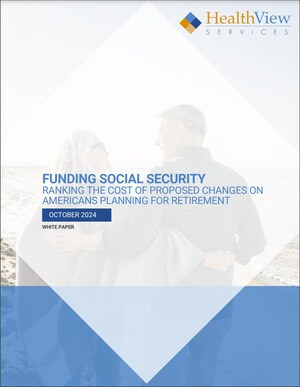Why Health Needs to Be Part of Retirement Planning: New HealthView Services White Paper
Latest retirement healthcare cost projections
Impact of health condition on retirement healthcare expenses
Savings or lump sum investment to address healthcare costs
Shortfalls when meeting income replacement ratio goals
Investment strategies to reduce healthcare costs
DANVERS, Mass., July 8, 2019 /PRNewswire/ -- A white paper from HealthView Services, Why Health Needs to Be Part of Retirement Planning, provides new data detailing the projected cost of healthcare, the impact of health conditions, and strategies to plan for, manage, and even reduce healthcare costs in retirement.
The report shows actuarially projected total lifetime healthcare costs for an average healthy 65-year-old couple retiring this year will be $387,644 in today's dollars. Total lifetime costs include premiums for Medicare Parts B and D, dental, and supplemental insurance as well as all out-of-pocket outlays for medical, dental, hearing and vision.
The paper notes costs will be significantly higher at the end of retirement rather than at the beginning. In 20 years, the couple can expect to pay $34,268 in future dollars for one year of health-related expenses. This excludes long-term care costs. Driven by healthcare inflation, projected to be 4.41%, health-related expenses for today's 40 and 50-year-olds will be even higher.
The report shows projected annual healthcare costs for healthy Americans will, on average, be lower than those of their counterparts with health conditions. But, because they are expected to live longer, the lifetime healthcare costs they need to plan for will be higher. A healthy 55-year-old woman living to her actuarial longevity of 89 will need to plan, on average, for $424,875 (future value) in lifetime healthcare costs. If she has Type 2 Diabetes, her actuarial longevity will be 80 and her projected total costs would be far lower at $266,163.
Since healthcare costs will be the highest at the end of retirement, living longer than actuarial averages will significantly increase expenses. For a 45-year-old couple, living two years beyond their projected longevity of 87 (male) and 90 (female) will add $172,273 in future dollars to their healthcare bill.
"Americans are not powerless when it comes to planning for future healthcare costs," said Ron Mastrogiovanni, CEO of HealthView Services and HealthyCapital. "Taking steps to improve health can reduce annual medical expenses. Investing these savings, increasing contributions to retirement plans, and working with an advisor to optimize product selection with healthcare in mind can significantly reduce this retirement burden."
The paper details how simple behavioral changes, including taking medication as prescribed and reducing salt intake, would enable a 45-year-old man with high blood pressure to lower his annual pre-retirement healthcare costs by an average of $3,651. Assuming a 6% rate of return, if he invested these savings, he'd be able to increase his retirement assets at age 65 by more than $110,000, while extending his actuarial longevity by more than two years.
Financial choices, both savings and investments, also make a difference. The report highlights the importance of investing to generate cash flow through retirement to match rising healthcare expenses. It outlines product choices, including using HSAs, Roth 401(k)s, Roth IRAs, and specific types of insurance products and annuities that can reduce the impact of Medicare surcharges.
The paper shows that by taking advantage of the benefits of compounding returns, the ongoing savings or lump sum investments required to address future healthcare needs are achievable. A 50-year-old man who has not saved for healthcare, would need to put aside $7,129 a year, before retirement at age 65, to cover his future Medicare B and D and supplemental insurance (Plan G) premiums. Or, he could contribute an additional $183 every two weeks to his 401(k), assuming a 6% return with a 50% company match, to cover these future premiums.
Individuals on track to meet the industry's standard 80% income replacement ratio target are addressing a portion of their future healthcare needs. But, the paper notes, they will need to increase contributions for healthcare to avoid falling short on their planning goals. This is because when working they only had to pay for approximately 25% of their premiums, with their companies making up the difference. In retirement, they will have to pay for 100% of premiums. Additional bi-weekly contributions required to close the gap between what they have saved and actual future healthcare expenses would be $120 for a 50-year-old man.
"Healthcare must be incorporated into the retirement planning process, and not simply because it is a significant expense that all Americans will face," added Mastrogiovanni. "Costs must be understood and managed within the context of existing savings, health conditions, Social Security benefits, investment choices, and other retirement factors so working Americans can generate enough income to cover future healthcare needs."
HealthView Services draws upon 530 million health care cases, actuarial, government and economic data to project retirement healthcare costs. The firm's rigorous bottom-up approach integrates specific variables – including health status, age, gender, income, and state of residence – that will drive future healthcare costs. The final calculations draw upon, and are consistent with, government healthcare inflation forecasts.
HealthView Services (www.hvsfinancial.com) is the leading provider of retirement healthcare cost data, Social Security optimization, and long-term care retirement planning tools for the financial services industry. HealthyCapital (www.healthycapital.com), the company's joint venture with Midwest hospital system, Mercy, provides tools and savings data from condition management to incentivize improved health and retirement healthcare savings.
SOURCE HealthView Services

WANT YOUR COMPANY'S NEWS FEATURED ON PRNEWSWIRE.COM?
Newsrooms &
Influencers
Digital Media
Outlets
Journalists
Opted In






Share this article